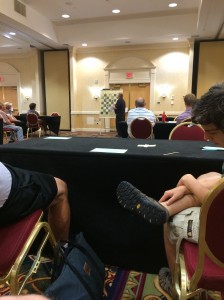
A few weeks ago, I had the pleasure of once again playing in the 136th New York State Championship. I did a bit worse than last year and lost rating points but I felt I played well and was a few moves away from winning in both of the games that I drew. In one particularly painful example, I outplayed a young opponent but was unable to find some critical moves in the ending. At the end I made such a terrible blundered that I should have lost! Thankfully, my opponent missed the winning combination and had his heart set on trying to draw. It reminds me of a quote frequently attributed to Nigel Short,
If your opponent offers you a draw, try to work out why he thinks he’s worse off. – Nigel Short
Although to be fair at that point our game was the second to last one playing in the room and I was so exhausted I didn’t even realize I was worse! As usual I attended part of IM Jay Bonin’s lecture where he analyzed a game he played (and won) against Gata Kamsky when Gata was first returning to tournament chess.
Some notable inclusions in this years tournament were current US champion Gata Kamsky, and GM Maxim Dlugy. Gata Kamsky won the tournament and never seemed like he was in any real trouble in any of the games. Here is his last round game against IM Alexandr Ostrovskiy:
At the end of the tournament, it was interesting to listen to Kamsky talk about Claude Bloodgood with Bill Goichberg. At one point Kamsky said, “I recall looking at the rating list and seeing him as number two after me and I was wondering, who the hell is this guy?”
There were fewer titled players in the open section than in years past. Many of the “mainstays” of the tournament sat out this year. It dawned on me that many players from downstate were playing in the New Jersey State Championship. I’m beginning to think that hosting this tournament in Albany is a poor idea. Perhaps the tournament should move around the state as it used to. As is tradition I roomed with my friend FM Ben Dean-Kawamura who is working on an interesting project. His idea converts chess annotations to an readable PDF (with any luck I’ll be able to share his findings sometime soon).
Enough prattle let’s analyze some chess games! In the first round, I played a master who demonstrated that my opening doesn’t allow for dynamic enough play for white. It was clear to me after I analyzed the game at home that he understood the ideas of the position much better than I did:
In the second round game I played against a player I had played a few years ago in this tournament from Long Island. I got into a cramped hedgehog-like formation out of the opening and felt like I was defending a lot. I got low on time and blundered in a worse position. After the game, he was kind enough to analyze the game with me and we discussed some of the nuances of the position.
I felt I played a good game in the third round. It was rich with complications and was the second to last game to finish of the day. After some maneuvering I obtained a pawn but entered, an opposite colored bishop endgame where it was clear I had an advantage. After mucking around for five or ten moves I finally came up with a reasonable plan. With an awesome trick, I picked off another pawn, leaving me with two connected past pawns. The issue is that we still had those pesky opposite colored Bishops. Once again, I found myself absorbing time trying to find the winning plan when I began marching my King towards the action. His counterattack was swift and approaching Zeitnot I began to feel that I was losing the thread of the game. He of course found some great moves and it occurred to me that I would have to give back the pawns. In the end, I offered a draw (after declining one earlier) that he accepted. Thankfully, he didn’t realize that he was on the cusp of winning a piece in that position.
With my .5/3, I began my fourth round game against a player from Ottawa (a fact I learned during our post-mortem). I managed to win the game but not without some lapses of judgment and misguided attacks. Ultimately, he made an exchange that left him with an inferior rook ending a pawn down. I converted in good style and he resigned.
After my first two losses, I had decided that I would do pre-game preparations in the opening. The final two-thirds of my tournament I was quite pleased with the way the openings went and the general flow of the games. As a player I find I’m no longer satisfied with these dull positions that don’t offer much for either side. One lesson I take away from this tournament is that I want to start playing sharper lines as black. Unfortunately, because I had two whites the second day I knew that Monday was going to be arduous. In the fifth round, my opponent was a young player who played a line that I had prepared before our game. I got a good position and equalized quickly. I managed to find myself in an opposite colored bishop ending where I was compelled to play on (as I was up a pawn with a dominant position). My opponent defended well and after two declined draw offers I finally relented and accepted the draw:
The final round was a bit of a disaster for me. I got exactly the position I was aiming for in my preparation only to realize that in all honesty, I didn’t want to play that position at all. I found myself defending a good knight vs bad bishop scenario. I made a couple poor decisions and I watched helplessly as my position crumbled.
The next tournament I will be playing in is the Hartford Open in Windsor Locks Connecticut. As is the new tradition for this post I have a few questions for next year and a few remaining questions from last year.
Questions to be Answered Next Year:
- Who was Claude Bloodgood?
- Will Gata Kamsky retire?
Unanswered Questions From Last Year:
- What is in Yefim Treger’s Fanny Pack?
- What is a modified median?
- Who was Ephraim Solkoff?
- When will the USCF embrace the increment over the delay?
